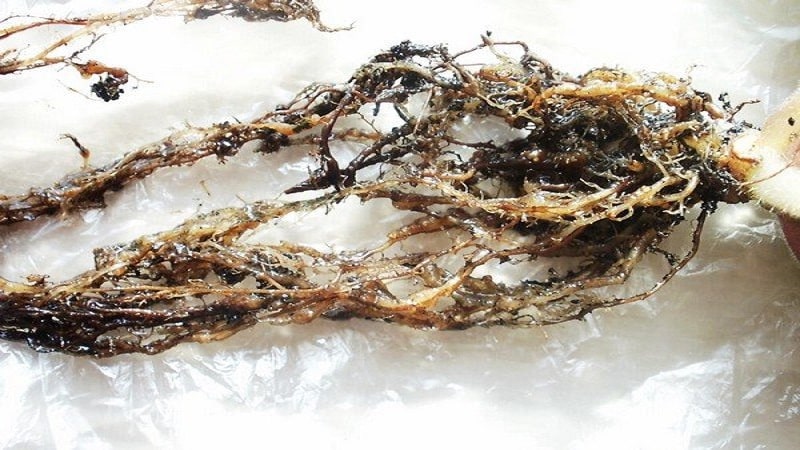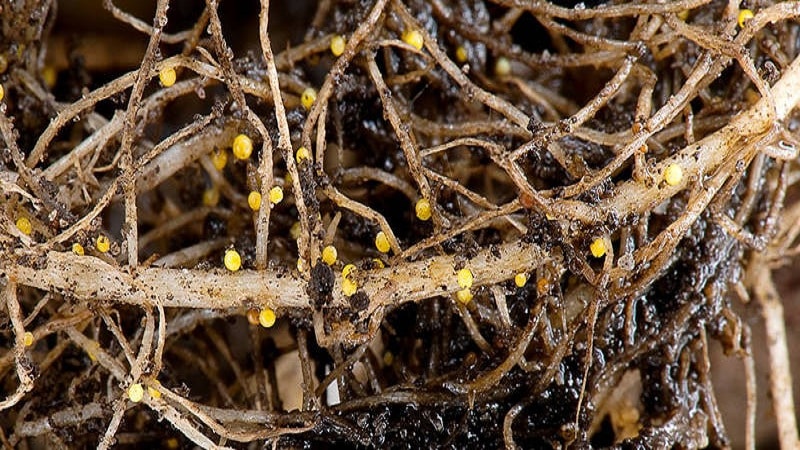What is potato nematode and how to fight it
The potato nematode appeared on the territory of the USSR in 1949. The first outbreaks of infection were detected in the Kaliningrad region. Microscopic worms are dangerous because in the first years of soil infection they do not affect the productivity of potatoes and their taste, but as they multiply and spread throughout the area, they destroy more than 60% of the crop.
Let's consider a description of the pest and methods of treating plants affected by it.
Description of the pest
The potato nematode is a quarantine pest belonging to the cyst nematodes of the Heteroderidae family (different-skinned nematodes). In addition to potatoes, it affects other plants of the Solanaceae family (eggplant, tomatoes, physalis). Depending on the climate, it produces 1-2 generations per year. Reproduction is bisexual.
Roundworms are distinguished by sharp sexual dimorphism (two different forms of individuals within the same species). The female is 380–1070 µm long and 275–965 µm wide. The body color is pearly white, the shape is hemispherical or oval. During development, the color changes from white to yellow. When entering the cyst stage, the female becomes golden.

The length of the male is 890–1270 µm, width – 31–46 µm. The body is worm-shaped, narrowed at the ends.
The larva is 366–570 µm long and 18–26 µm wide. The body is narrowed on both sides.
The vital activity of adult individuals takes place inside the potato rhizome at a temperature of +15…+20°C. Males do not feed.Their main task is to find a female and fertilize her within 10 days. After this, the male dies.
One female reproduces 200–1000 eggs, which overwinter in a cyst (dead female with eggs). The cyst easily leaves the roots and remains in the soil until spring. At an air temperature of +12°C, larvae appear and infect potatoes.
One generation develops over 38–48 days. Wet weather with prolonged rains promotes intensive reproduction and development of the potato nematode.
Types of nematodes
There are several types of roundworms: golden, stem, pale, gall, leaf. Potatoes are susceptible to infection by golden nematode.

Golden
The pest penetrates the rhizome and feeds on plant juices. This makes it difficult for nutrients to reach the stems, greens and young tubers. The potato bush begins to dry from the lower leaves. Tubers are formed small or not formed at all. The rhizome is highly branched. This phenomenon is popularly called beardiness.
Males resemble tiny worms. The body of females is spherical, 384 days after fertilization it is filled with eggs. By autumn it darkens and becomes golden-brown.
The photo shows the golden potato nematode.

Stem
This worm, only 1.7 mm in size, infects potato stems and tubers. Small dark spots are clearly visible on the infected tuber. Under the skin, areas of loose, light-colored pulp are visible. The surface becomes covered with cracks, and dry rotten rot forms underneath.
Stem nematode develops under excessive moisture. The worm parasitizes in damp cellars, crawling from tuber to tuber, infecting all planting material.
Pale
The pallid nematode has a development cycle similar to the golden nematode, differing only in color. In this case, the female’s white body acquires a brown tint.
The first signs of defeat - sickly looking bushes. On such plants, no more than 3 stems are formed, which turn yellow prematurely. The infection spreads upward, starting from the lower leaves, and gradually covers the entire bush.
A small number of small potatoes weighing no more than 40 g are formed on a diseased bush.
Gallovaya
The root-knot nematode attacks potato roots and tubers. It parasitizes pumpkin crops: zucchini, squash, melons, pumpkins. Lumps, sometimes growths, up to 3 cm in diameter appear on the tubers. The infected plant experiences a lack of nutrients and moisture.
Leafy
The smallest type of nematode. The length of the worm does not exceed 1 mm. The body is colorless. The pest moves inside the infected plant, provoking the addition of viral infections.
Leaf nematodes parasitize not only potatoes, but also chrysanthemums and tomatoes.
Yellowish spots appear on the leaves. Soon the greenery dries and falls off. The worm spreads through wounds on the plant.
Symptoms of the lesion

The danger of potato nematode lies in the hidden course of the disease. The first signs appear when the number of pests reaches a critical point. “Bald spots” appear on the potato plantation: yellow and dry bushes can be seen among the green mass. The tubers are getting smaller.
Under a magnifying glass, small round cysts resembling grains of sand are visible. They are often invisible, but at the slightest suspicion, it is better to take the wilted bush to the laboratory.
How to deal with a pest
The potato nematode is defined by the following expression: “It does not burn in fire, it does not drown in water.”To fight with pest very difficult, for this a whole range of measures is carried out, including agrotechnical techniques and treatment with chemicals. However, no product guarantees absolute effectiveness. Farmers in EU countries have extensive experience in combating the nematode, given that it appeared there earlier than in the Russian Federation.
Reference. If your site is located in a quarantine zone, if you follow a number of rules, you will be able to grow excellent potatoes. It is important to remember: a product from such a zone is used in cooking, but is not sold in other regions.
The final victory over the potato nematode will take more than a decade of continuous work, but the pest population can be reduced in 1-2 years.
If there are no more than 3–5 cysts per 100 cm3 of soil, there will be no harm to the potatoes. A significant decrease in yield is observed when 10–16 cysts are detected per 100 cm3 of soil.
Agrotechnical methods

To combat the pest, simple but effective agrotechnical and preventive methods are used:
- Crop rotation. Potatoes are not planted in the same area for several years in a row. Even when planting a crop in one place no more than once every 3-4 years, a serious increase in the nematode population will not occur earlier than in 40-45 years.
- Varieties resistant to the pest are planted only 3 years in a row; the next year, ordinary planting material is chosen. There is another option - to grow only crops with a high degree of protection, but change varieties every 4 years.
- In autumn, potato tops and weeds are removed from the infected area and burned, taking precautions. Working tools are disinfected with a 4% Formalin solution.
- In autumn and spring, the soil is fertilized with urea. Nitrogen is harmful to the potato nematode.If the pest spreads insignificantly in the area, they dig a hole, dump tops and weeds into it, cover everything with urea (5-6 kg/1 m3 of green mass), and sprinkle it on top with soil from a “clean” area.
- Healthy material is chosen for planting. The tubers are washed and treated with a solution of potassium permanganate (0.5 g/10 l).
- When planting, add 1 tbsp to the holes. l. bird droppings. A solution is prepared from fresh droppings in a ratio of 1:10 and the area is watered.
- Rye, beans, peas, marigolds, clover, and mustard are planted next to the beds. The roots of these plants secrete substances that are harmful to the nematode. If you sow rye on a field in the second decade, up to 90% of the larvae are destroyed, and rotted straw serves as fertilizer in the spring. Nodules containing nitrogen form on the roots of legumes. Seeds are added directly to the holes or planted between rows of potatoes.
- Ringed (earthworms) are natural enemies of nematodes. Increasing soil fertility creates favorable conditions for their reproduction.
Chemical method
When the potato nematode spreads massively, chemicals are used. Treatment is carried out 6 weeks before planting the crop, following the manufacturer’s recommendations.
To destroy nematodes, potent fungicides are used: Chloropicrin, bromomethane (methyl bromide), Nemagon. These products are released in the form of poisonous gases. They treat soil and seed material. Penetrating into the respiratory system of worms, toxins cause their death. Work is carried out wearing skin and respiratory protection.
Preparations based on organophosphorus nematicides (Lindane, Karbofos, Phosfamide) are used to eliminate stem and leaf nematodes. The prepared solutions are used to irrigate the planting material.
Important! Considering the high toxicity of agents against potato nematodes, landing tubers in treated areas are produced after 20–50 days.
Biological products “Basamil”, “Fitohit”, “Nematofagin BT”, “Pecilomycin” do not have a toxic effect on tubers and are effective against the pest.
Traditional methods
One of the most effective folk methods of getting rid of nematodes is pouring boiling water on the soil. No herbal infusions or decoctions will cope with the pest.
The infected area is evenly poured with boiling water to a depth of 20 cm. A plastic film is stretched over the top. This way the earth will cool down more slowly. The method destroys worms that settle only in the top layer of soil. The nematode, parasitizing in the deep layers, moves to another part of the garden.
Harm to humans
The pest does not pose a danger to humans. However, it is undesirable to eat tubers affected by the nematode: they lose their taste and acquire an unattractive presentation.
Potato varieties resistant to nematode

The table shows varieties with immunity to nematodes. The root system of plants resists parasites, killing about 80% of worms.
| Name | Originator | Ripening time, days | Tuber weight, g | Productivity, c/ha |
| Limonka | Agrico | 110–120 | 75–125 | 193–315 |
| Krinitsa | RUE "Scientific and Practical Center of the National Academy of Sciences of Belarus for Potato Growing and Horticulture" | 110–120 | 88–136 | 171–280 |
| Red Scarlet | HZPC HOLLAND B.V. | 70–80 | 56–102 | 164–270 |
| Atlant | RUE "Scientific and Practical Center of the National Academy of Sciences of Belarus for Potato Growing and Horticulture" | 110–120 | 90–119 | 164–260 |
| Rosara | SAKA PFLANZENZUCHT GBR | 50–65 | 81–115 | 202–260 |
| Stonefly | RUE "Scientific and Practical Center of the National Academy of Sciences of Belarus for Potato Growing and Horticulture" | 110–120 | 93–127 | 235–368 |
| Uladar | RUE "Scientific and Practical Center of the National Academy of Sciences of Belarus for Potato Growing and Horticulture" | 50–65 | 91–140 | 127–261 |
| Lily Belarusian | RUE "Scientific and Practical Center of the National Academy of Sciences of Belarus for Potato Growing and Horticulture" | 65–70 | 102–200 | 246–407 |
| Yanka | RUE "Scientific and Practical Center of the National Academy of Sciences of Belarus for Potato Growing and Horticulture" | 90–100 | 81–106 | 195–360 |
| Zekura | Solana | 80–95 | 59–150 | 195–365 |
| Arizona | Agrico | 70–80 | 112–150 | 255–577 |
Conclusion
The potato nematode is an insidious pest that can leave a gardener without a harvest if control measures are not taken in time. It is difficult to destroy it, but compliance with the rules of agricultural technology and preventive measures (crop rotation, removal of tops and weeds, disinfection of seed material, selection of varieties resistant to the pest, nitrogen fertilization), treatment of potatoes with fungicides based on organophosphorus nematicides and toxic gases, watering the beds with boiling water greatly reduce worm population.